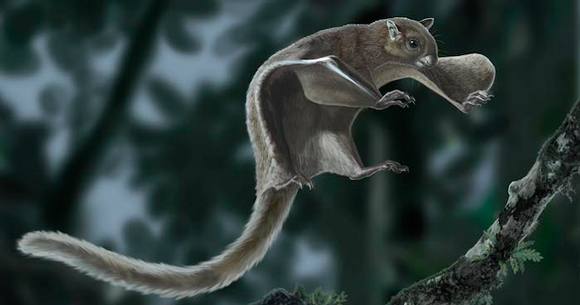Remarkable Giant Flying Squirrel Redraws Family Tree
Flying Squirrel Fossil Sorts Phylogeny
The fossilised remains of a large flying squirrel unearthed at a landfill site in north-eastern Spain (Catalonia), has helped researchers to re-write the family tree of the Sciuridae family. Estimated to have been around one metre in length (including tail) and weighing up to 1.6 kilograms, the newly described squirrel species named Miopetaurista neogrivensis is around the size of the largest flying squirrels today, the Chinese giant flying squirrel (Petaurista alborufus). Its fossils show that the flying squirrel body plan has not changed for millions of years.
A Life Reconstruction of the Newly Described Miopetaurista neogrivensis (Middle-Late Miocene of Europe)

Picture credit: Óscar Sanisidro
Mistaken for a Primate
The fossils, including most of the skull and jaws from a single individual, were discovered in 2002, when alterations were being made to the landfill site. At first, it was thought that the long, thin bones represented a primate, as simian fossils are known from these Miocene-aged deposits.
One of the authors of the scientific paper, published in the journal eLife, Óscar Sanisidro (University of Kansas Biodiversity Institute and Natural History Museum), takes up the story:
“That area is very rich in fossils. The recovered specimen was unearthed by an excavator machine while digging up a sector of the landfill. They could only see a couple of bones poking out from the debris. They thought it might be a species of primate because of its limb proportions, maybe Pliopithecus, a small monkey found in the area. Additionally, the presence of a lot of early hominoids in the nearby deposits posed it as an excellent place to look for those animals.”
A Giant Flying Squirrel
Once the block of stone containing the fossil material had been removed and work had started to clean and prepare the bones, it soon became clear that the fossils represented a super-sized rodent. The key to identifying the specimen as a flying squirrel came in the discovery of the specialised wrist bones (pisiforms) which are unique to flying squirrels. These bones attach to a spur of cartilage that supports the skin membrane (patagium), that allows these arboreal specialists to glide. Once a pisiform bone had been identified in the specimen, it became clear to the research team that these fossils represented a flying squirrel.
The fossils, dated to approximately 11.6 million years ago (Serravallian to Tortonian faunal stage of the Middle to Late Miocene), are very similar to the skeletons of living flying squirrels. Miopetaurista neogrivensis, is the oldest flying squirrel fossil found to date that has a modern-looking anatomy and it shows that these mammals have remained almost unchanged for nearly 12 million years.
Views of the Fossilised Bones and Teeth of the Newly Described Miocene Flying Squirrel M. neogrivensis

Picture credit: Óscar Sanisidro
Redrawing the Evolutionary Family Tree of the Sciuridae
This Spanish fossil discovery has helped palaeontologists to redraw the evolutionary tree of the squirrel family. That branch of the Sciuridae that led to modern flying squirrels must have diverged many millions of years earlier than previously thought. This spilt is now believed to have occurred sometime between 31 and 25 million years ago.
The Phylogeny of the Flying Squirrels – M. neogrivensis Helps to Redraw the Squirrel Family Tree

Picture credit: eLife
The researchers identified Miopetaurista neogrivensis as sister taxon of the living Petaurista taxon following an in-depth Bayesian statistical analysis that looked at over 100 anatomical characteristics in 38 taxa. The team were also able to plot key periods in the evolution of these mammals and link them to incidences of environment and climate change such as the mid-Miocene climate optimum (global warming) and the onset of Arctic glaciation (global cooling).
Commenting on the significance of the fossils and their impact on squirrel phylogeny, Óscar Sanisidro stated:
“When working with tree squirrels and flying squirrels, some of the features we thought were unique to flying squirrels have been found by our team in some non-flying squirrels. Right now, we don’t have features unique to flying squirrels except for the wrist. With fossils of micromammals, ninety-nine percent of the time you’re working with teeth. Wrist bones are extremely rare. But now we can link those traits to the postcranial skeleton. Some of the flying squirrels found in the past might not be flying squirrels because they might have had features common to other groups.”
Well-adapted to a Forest Environment
Flying squirrels today are globally distributed, but most species are found in Asia. It is likely that, just like its extant descendants, Miopetaurista neogrivensis was probably nocturnal and very much at home in its sub-tropical forest environment. It is not known what this ancient flying squirrel ate, today’s flying squirrels have a variety of feeding behaviours, however, Miopetaurista was probably omnivorous, feeding on nuts, fruit and insects.
Spain in the Mid Miocene – A Sub-tropical Forest Environment

Picture credit: Óscar Sanisidro
Visit the Everything Dinosaur website: Everything Dinosaur.

